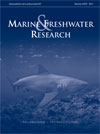Marine and Freshwater Research
Volume 62
Number 12 2011
A comparison of water chemistry in urban and non-urban streams revealed that each group had distinct and different ionic composition. Urban streams were more saline and had higher bicarbonate and calcium levels than were measured in reference streams. This study concluded that concrete urban drainage infrastructure is responsible for some of the observed differences in urban stream geochemistry.
The impact of metals on aquatic organisms is often tested using one species at a time, which can result in over- or underestimations of the toxic effect. In this work we assessed the impact of copper on a microalga in the presence and absence of biofilms collected from the ocean. Toxicity of copper was sometimes reduced when the biofilm was added, but the results varied.
Drought and drying of perennial streams decrease the number of species of macroinvertebrates and their abundance in stream communities. We explored hyporheic and surface benthic macroinvertebrate community changes associated with low flow and flow cessation conditions during a supra-seasonal drought on two normally perennial rivers: the Cotter and Queanbeyan Rivers (Canberra, ACT), to determine whether the hyporheic zone acts as a refuge for such species under these conditions. Low flow had no impact on macroinvertebrate taxa richness or density in either surface benthic or hyporheic habitats, whereas density and taxa richness declined during streambed drying, suggesting that the hyporheic zone did not provide a refugium for some taxa during these dry conditions.
Biological reference points may be influenced by uncertainties of life-history parameters and fishing practices. Present study examined the consequences of ignoring various sources of uncertainties using a simulation approach. Results indicated that biological reference points are sensitive to the parameters of weight–length relationship and growth.
Spiny dogfish are a small, long-lived, slow-growing shark species and in the Gulf of Alaska there is limited data for management. Demographic analyses suggest that the species is highly susceptible to over-fishing and can only tolerate a low level of harvest. Currently, there is no directed fishing for any sharks in the GOA; however, there is potential for market demand and thus interest in targeting spiny dogfish to increase.
Understanding whether environmental flows restore aquatic biota is crucial for the effective management of freshwater ecosystems. We found downstream macroinvertebrates in the highly regulated Snowy River, Australia, did not improve despite the provision of an environmental flow regime (EFR). Our study showed that restoration may be ineffective if EFRs are too small to overcome adverse environmental conditions and dispersal barriers.
Conservation and management of sharks requires an understanding of ontogenetic habitat linkages. A combination of acoustic tracking, catch data, chemical composition of the vertebrae and dietary analyses showed that bull sharks move from estuarine habitats where they are born to offshore waters as they grow. This stage-specific habitat dependency makes them susceptible to the habitat alteration that is occurring globally.
Biogeochemical factors exert great influence on the spatial and temporal patterns of benthic habitats. This study includes these factors in the development of benthic habitat maps for a temperate marine embayment in SE Australia which better define the infaunal communities and habitats. In absence of biological data, such benthic habitat maps can inform management of marine resources and biodiversity.




